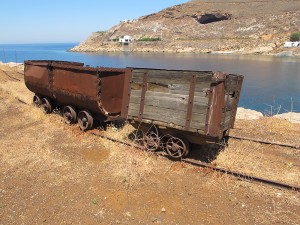I have been hiking some more through the dry heat of the island and enjoying the sweat and the feeling of the hot air going into my lungs as I breathe. Most of the walks have been around 12 km and primarily on well-traveled paths or roads. That is a drawback since walking on pavement is terrible for my legs and back. Tomorrow I head back out to Kolimbithres, but this time I will skirt the rocky edge of the island, bushwhacking through the dry, thorny underbrush. The goal will be the same: the beach and swimming. I’ll try to get some pictures. I must say that I am enjoying the solo hiking. It allows me to clear my head and think thoughts both shallow and deep. I guess I just let them come and go as I walk, similar to a walking meditation in Buddhism. Awareness of the steps I take and the objects to use and avoid while hiking is part of the meditation. John Pack, the director of the Aegean Center believes that hiking is one of the ways we exercise the brain. I can see his point. As I walk though the uneven surfaces of rock, dirt and thorn my brain is calculating and sending millions of mathematical signals to my muscles and tendons, making sure I do not fall or slip. Mindful awareness and the physical world. Emerson would like that.
Speaking of the poet, I was reading him this morning and in his essay ‘Domestic Life’ he discusses the concept of beauty. For him, beauty is all but indefinable and certainly transient. Beauty, as he would agree, is in the eye of the beholder. He wrote, “Beauty is, even in the beautiful, occasional,-or as one has said, culminating and perfect only a single moment before which is unripe, and after which it is on the wane. But beauty is never quite absent from our eyes. Every face, every figure suggests its own right and sound estate.”
Beauty is fleeting, random, changeable like the weather. Thus have been my affections, although their emotional imprint remains fossilized and frozen in time. I look back on the record with wistful, sometimes misty, eyes and wonder what would have been had the timing been different, the light at a different angle, something…Beauty, though, to me at least, remains fixed. I still think of past loves as beautiful, for there was beauty in the thinking and acting. None of them, I must admit, retain any angelic nature of memory. Certainly nothing devious either, and I have never fooled myself into thinking that there was anything other than a normal, human connection at work. To think otherwise would be to elevate these affections atop a pedestal and denigrate my own existence beneath them. Neither of these are real. So I will remember Emerson’s observation that beauty, like the cherry blossoms below, is real and on the vine yet subject to the shifting climate.
JDCM


